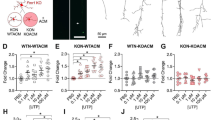Abstract
Starting from knowledge obtained in our previous studies of experimental dysraphism in chick embryos, the entity of neuronal over-growth observed in exencephaly was further investigated. The ontogenic expression of neuron-specific enolase (NSE), vasoactive intestinal polypeptide (VIP), and somatostatin was analyzed both in chick exencephaly of the natural product and in normal chick fetuses by carrying out immunohistochemical studies. In normal fetuses, immunostained elements positive for NSE first appeared in the spinal gray matter on postincubation day 16 and increased in intensity during the fetal period. By postnatal day 2, the cerebral peduncle, brain stem neurofibers, molecular layer of the cerebellum, corpus striatum, and piriform cortex became immunoreactive. No immunohistochemical reaction to VIP was observed during these stages. Somatostatin-positive elements were not identified during the fetal period, except in limited regions, such as the corpus striatum, which appeared to have weakly positive straining on day 21. The exencephalic fetuses, however, demonstrated extremely advanced neuronal maturation, with intense immunoreactivity already being manifest in various regions, including the corpus striatum, piriform cortex, spinal gray matter, and brain stem nuclei, on day 16 of the fetal period. Somatostatin-positive elements also appeared at this stage in chick exencephaly, but such immunoreactivity was localized, particularly in the overgrown foci. The present study showed that the neuronal maturation process in some neurons of exencephalic brain and spinal cord was definitely further advanced than that in normal controls. A possible clinical application of NSE and somatostatin measurement as markers for dysraphic states in the fetus is suggested.
Similar content being viewed by others
References
Barry A, Pattern BM, Stewart BH (1957) Possible factors in the development of the Arnold-Chiari malformation. J Neurosurg 14:286–301
Chesselet MF, Reisine TD (1983) Somatostatin regulates dopamine release in rat striatal slices and cat caudate nuclei. J Neurosci 3:232–236
Ellis WG, De Roos F, Kavlock RJ, et al (1988) Relationship of periventricular overgrowth to hydrocephalus in brains of fetal rats exposed to benomyl. Teratogenesis Carcinog Mutagen 8:377–391
Epelbaum J, Brazeau P, Tsang D, Brawer J, Martin JB (1977) Subcellular distribution of radio immunoassay-able somatostatin in rat brain. Brain Res 126:309–323
Finley JCW, Maderdrut JL, Roger LJ, Petruz P (1981) The immunocytochemical localization of somatostatin containing neurons in the rat central nervous system. Neuroscience 6:2173–2192
Forlim G, Hohmann C, Coyle JT (1990) Developmental expression of somatostatin in mouse brain. I. Immunohistochemical studies. Dev Brain Res 53:6–25
Ganchrow D, Ornoy A (1979) Possible evidence for secondary degeneration of central nervous system in the pathogenesis of anencephaly and brain dysplasia: a study in young human fetuses. Virchows Arch 384:285–294
Hogge WA, Thiagarajah S, Ferguson JE II Schnatterly PT, Harbert GM Jr (1989) The role of ultrasonography and amniocentesis in the evaluation of pregnancies at risk for neural tube defects. Am J Obstet Gynecol 161:520–524
Kaji H, Chihara K, Minamitani N, Kodama H, Yanaihara N, Fujita T (1983) Release of vasoactive intestinal polypeptide into the cerebrospinal fluid of the fourth ventricle of the rat: involvement of cholinergic mechanism. Brain Res 269:303–310
Katz VL, Chescheir NC, Cefalo RC (1990) Unexplained elevations of maternal serum alpha-fetoprotein. Obstet Gynecol 162:83–86
Nishimura M, Takashima S, Takeshita K, et al (1985) Developmental changes of neuron-specific enolase in human brain: an immunohistochemical study. Brain Dev 7:1–6
Oi S, Saya H, Matsumoto S (1988) A hypothesis for myeloschisis: over-growth and reopening. An experimental study. J Neurosurg 68:947–954
Oi S, Kokunai T, Okuda Y, Sasaki M, Matsumoto S (1990) Identical embryopathogenesis for exencephaly and myeloschisis: an experimental study. J Neurosurg 72:450–457
Osaka K, Tanimura T, Hirayama A, et al (1978) Myelomenigocele before birth. J Neurosurg 49:711–724
Padmanabhan R (1984) Experimental induction of cranioschisis aperta and exencephaly after neural tube closure. J Neurol Sci 66:235–243
Padmanabhan R (1988) Light microscopic studies on the pathogenesis of exencephaly and cranioschisis induced in the rat after neural tube closure. Teratology 37:29–36
Pattern BM (1952) Overgrowth of the neural tube in young human embryos. Anat Rec 113:381–393
Sato K, Nakagata N, Hung CF, et al (1985) Transplacental induction of myeloschisis, associated with hind brain crowding and other malformations in the central nervous system in Long-Evans rats. Child's Nerv Syst 1:137–144
Schmid BP, Kao H, goulding E (1985) Evidence for reopening of the cranial neural tube in mouse embryos treated with cadmium chloride. Experientia 41:271–272
Shambra UB, Sulik KK, Petrusz KK, Lander JM (1989) Ontogeny of cholinergic neurons in the mouse for brain. J Comp Neurol 288:101–122
Thal LJ, Laing K, Horowitz SJ, Makman MH (1986) Dopamine stimulates rat cortical somatostatin release. Brain Res 372:205–209
Van den Hof MC, Nicolaides KH, Campbell J, et al (1990) Evaluation of the lemon and banana signs in one hundred thirty fetuses with open spina bifida. Am J Obstet Gynecol 162:322–327
Watanabe M, Saloira K, Takahashi Y, Kondo H (1990) Ontogenic changes in expression of neuron-specific enolase (NSE) and its mRNA in the Purkinje cells of the rat cerebellum: immunohistochemical and in situ hybridization study. Dev Brain Res 53:89–96
Author information
Authors and Affiliations
Rights and permissions
About this article
Cite this article
Oi, S., Matsumae, M., Sato, O. et al. Neuronal overmaturation in dysraphism: ontogenic expression of neuropeptides in the fetal brain and developmental anomalies in exencephaly. Child's Nerv Syst 11, 504–510 (1995). https://doi.org/10.1007/BF00822839
Received:
Issue Date:
DOI: https://doi.org/10.1007/BF00822839




